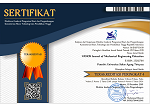Development of Android-Based Starter Motor Learning Media for Improving Students 'Abilities and Knowing its Learning Motivated Achievements
Abstract
This study aims to develop Android-based learning media to improve students' abilities regarding the reduction type starter motor system and to determine the acquisition of learning motivation. The method used is pre-experimental design in the form of one-group pretest-posttest, while media development uses the ADDIE method. The population of this study were students who contracted electricity courses. The results of this study indicate an increase in the learning outcomes of the Pre-Test and Post-Test which is significant with the acquisition of the significance test using the t test with a significance value of 0.000, this increase is due to the use of android-based learning media that has been made. So that this learning media has a good impact on increasing students' insight in using technology, especially Android for learning uses. In addition, the students' learning motivation on average is in the category motivated by this media.
Keywords
Full Text:
PDFReferences
D. P. R. R. INDONESIA and P. R. INDONESIA, UNDANG-UNDANG REPUBLIK INDONESIA NOMOR 20 TAHUN 2003 TENTANG SISTEM PENDIDIKAN NASIONAL. INDONESIA, 2003.
Menteri Pendidikan dan Kebudayan, SURAT EDARAN MENDIKBUD NO 4 TAHUN 2020 TENTANG PELAKSANAAN KEBIJAKAN PENDIDIKAN DALAM MASA DARURAT PENYEBARAN CORONA VIRUS DISEASE (COVID- 1 9). Indonesia: Pusdiklat kemdikbud, 2020.
M. H. Lin, H. C. Chen, and K. S. Liu, “A study of the effects of digital learning on learning motivation and learning outcome,” Eurasia J. Math. Sci. Technol. Educ., vol. 13, no. 7, pp. 3553–3564, 2017, doi: 10.12973/eurasia.2017.00744a.
M. A. Ramdhani and H. Muhammadiyah, “The Criteria of Learning Media Selection for Character Education in Higher Education,” Proceeding Int. Conf. Islam. Educ. Reforms, Prospect. Challenges Fac. Tarb. Teach. Training, Maulana Malik Ibrahim State Islam. Univ. Malang, pp. 174–182, 2015.
M. J. Kintu, C. Zhu, and E. Kagambe, “Blended learning effectiveness: the relationship between student characteristics, design features and outcomes,” Int. J. Educ. Technol. High. Educ., vol. 14, no. 1, 2017, doi: 10.1186/s41239-017-0043-4.
Toyota, New Step 2 Training Manual, First. Jakarta: PT. Toyota Astra Motor, 2002.
R. A. Prasetyo, I. Mubarak, R. A. M. Noor, S. Sriyono, M. Nurtanto, and I. Sutia, “APPLICATION OF TURBOCHARGER STAND CUTTING SYSTEM TOWARD IMPROVEMENT OF LEARNING ACHIEVEMENTS ON MOTOR BENSIN,” J. Mech. Eng. Educ., vol. 7, pp. 57–64, 2020, doi: https://doi.org/10.17509/jmee.v7i1.29442.
Daryanto and T. Rachmawati, Teori Belajar dan Proses Pembelajaran Yang Mendidik, 1st ed. Yogyakarta: Gava Media, 2015.
E. Siregar and H. Nara, Teori Belajar Dan Pembelajaran, 1st ed. Bogor: Ghalia Indonesia, 2010.
G. T.Page and J. B.Thomas, International Dictionary of Education. London: The MIT Press, 1979.
E. Kyndt, D. Gijbels, I. Grosemans, and V. Donche, “Teachers’ Everyday Professional Development: Mapping Informal Learning Activities, Antecedents, and Learning Outcomes,” Rev. Educ. Res., vol. 86, no. 4, pp. 1111–1150, 2016, doi: 10.3102/0034654315627864.
A. Arsyad, Media Pembelajaran. Jakarta: Grafindo Persada, 2011.
T. Permana, Kelistrikan Otomotif 2. (Bahan ajar). Bandung: Jurusan Pendidikan Teknik Mesin, Universitas Pendidikan Indonesia, 2008.
L. Cheung, “Using the ADDIE Model of Instructional Design to Teach Chest Radiograph Interpretation,” J. Biomed. Educ., vol. 2016, pp. 1–6, 2016, doi: 10.1155/2016/9502572.
B. Saputro, Manajemen Penelitian Pengembangan (Research & Development) bagi Penyusun Tesis dan Disertasi, vol. 53, no. 9. Yogyakarta: Aswaja Pressindo, 2017.
S. Rabiah, “Penggunaan Metode Research and Development dalam Penelitian Bahasa Indonesia di Perguruan Tinggi,” pp. 1–7, 2016, doi: 10.31227/osf.io/bzfsj.
R. Masykur, N. Nofrizal, and M. Syazali, “Pengembangan Media Pembelajaran Matematika dengan Macromedia Flash,” Al-Jabar J. Pendidik. Mat., vol. 8, no. 2, p. 177, 2017, doi: 10.24042/ajpm.v8i2.2014.
S. Arikunto, Prosedur penelitian : suatu pendekatan praktik, Rev. VI. Jakarta: Rineka Cipta, 2011.
A. Suharsimi, Prosedur Penelitian Suatu Pendekatan Praktik. Jakarta: Rineka Cipta, 2013.
M. Asbari, P. B. Santoso, and A. Purwanto, “Pengaruh Kepemimpinan dan Budaya Organisasi Terhadap Perilaku Kerja Inovatif pada Industri 4.0,” Jim UPB, vol. 8, no. 1, pp. 7–15, 2019, doi: ttps://doi.org/10.33884/jimupb.v8i1.1562.
H. Taherdoost, “Validity and Reliability of the Research Instrument; How to Test the Validation of a Questionnaire/Survey in a Research,” SSRN Electron. J., no. January 2016, 2018, doi: 10.2139/ssrn.3205040.
H. Retnawati, Analisis Kuantitatif Instrumen Penelitian, Cetakan Pe. Yogyakarta: Parama Publishing, 2016.
N. Herhyanto, Statistika Pendidikan. Tangerang Selatan: Universitas Terbuka.
I. Zahara, “the Effectiveness of Using Guided Discovery in Teaching Reading Comprehension,” Edukasi J. Pendidik. dan Pengajaran, vol. 4, no. 2, pp. 66–73, 2017, doi: 10.19109/ejpp.v4i2.1563.
R. E. Walpole and R. H. Myers, Ilmu peluang dan statistika untuk insinyur dan ilmuwan, 2nd ed. Bandung: ITB Press, 1995.
A. Emda, “Kedudukan Motivasi Belajar Siswa Dalam Pembelajaran,” Lantanida J., vol. 5, no. 2, p. 172, 2018, doi: 10.22373/lj.v5i2.2838.
M. Nurtanto, “Peningkatan Motivasi Dan Prestasi Belajar Dengan Metode Problem Based Learning Pada Pembelajaran Gambar Teknik Melalui Pembelajaran Terbimbing,” VANOS J. Mech. Eng. Educ., vol. 1, no. 2, pp. 201-216., 2016, doi: http://dx.doi.org/10.30870/vanos.v1i2.1021.
DOI: http://dx.doi.org/10.30870/vanos.v6i1.9600
Refbacks
- There are currently no refbacks.

This work is licensed under a Creative Commons Attribution 4.0 International License.


.png)
.png)
